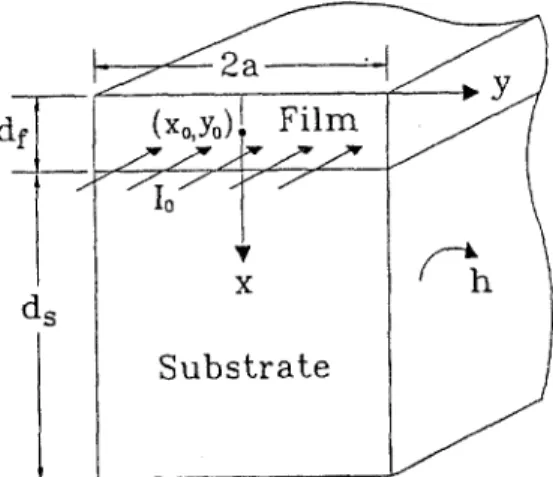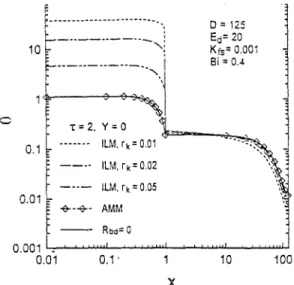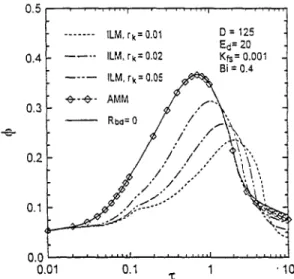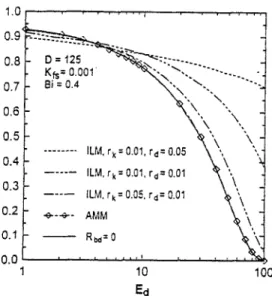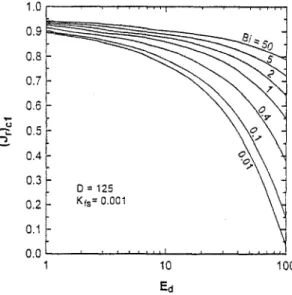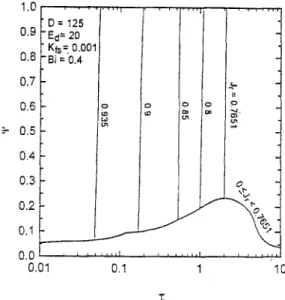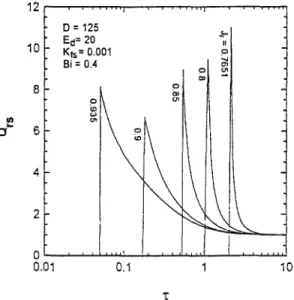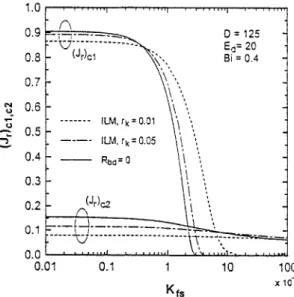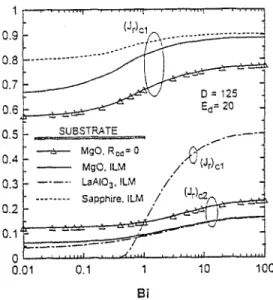Journal of Thermal Analysis, VoL 48 (1997) 951-969
INTRINSIC THERMAL STABILITY AND QUENCHING
RECOVERY OF THIN-FILM SUPERCONDUCTORS WITH
THERMAL BOUNDARY RESISTANCE
J.-P Wu and H.-S. Chu
Department of Mechanical Engineering, National Chiao Tung University, Hsinchu, Taiwan 300, Republic of China
Abstract
The stability behaviour of a thin-film superconductor under a localized release of thermal disturbance is investigated. Two-dimensional conjugate film/substrate conduction equation with anisotropic thermal conductivity of the film, and Joule heat are employed to investigate effects of substrate and thermal properties on the intrinsic stability and quenching recovery. To consider the thermal boundary resistance between film and substrate, an interfacial-layer model (ILM) with very low diffusivity and an acoustic mismatch model (AMM) are employed. Results show that the thermal boundary resistance influences strongly the intrinsic stability. Thermal boundary resistance increases intrinsic stability if the thermal conductivity of the substrate or the distur- bance energy is large. Higher Biot numbers and thermal conductivity ratios of film to substrate in longitudinal direction influence stability favorably. We demonstrate also that operation of a film/substrate system, such as YBCO/MgO, is either intrinsically stable or irrecoverably unstable.
Keywords: thermal boundary resistance, thermal stability, thin-film superconductor
Introduction
The stability in the presence of thermal disturbances is one of the most impor- tant problems in the application of thin-film superconductors. The thermal distur- bances are most likely due to transient, localized, point-source heat releases and are produced by various mechanisms, such as sudden relaxation of dislocations, crystal defects, and other spontaneous processes in superconductors [1-2]. The en- ergy can increase the temperature level of the superconductor to the transition point where superconductors stop superconducting state and become normal resistive ma- terials, a phenomenon known as quenching. As the local temperature is raised, the critical current density is reduced, in turn, the current is distributed to the other un- disturbed region. If the operating current can not be accepted by the undisturbed re- gion, Joule beating will occur. To keep the superconductors superconducting, it is necessary to provide adequate heat transfer after the occurrence of thermal distur- bances and Joule heating. Understanding the heat transfer behavior of superconduc- tor film/substrate composite, which is therefore of great importance.
The thermal properties of substrates are important factors which affects signifi- cantly the thermal stability of superconductors. Generally, larger substrates with
0368--4466/97/$ 5.00 John Wiley & Sons Limited
952 WU, CHU: THIN-FILM SUPERCONDUCTORS
better thermal conductivity will be considered good heat sinks, and increase in size also increase their heat capacities. Therefore, substrate effects are not negligible.
In addition to substrate effects, the thermal boundary resistance between the su- perconducting thin film and the substrate also greatly affects the thermal stability. The existence of thermal resistance diminishes the substrate effects and heat gener- ated in the film is conducted to the substrate with difficulty, Wetzko et al. [3] dealt with the stability of Bi-2223/Ag, transport current distribution and current-sharing in considering thermal boundary resistance. They found that the influence of ther- mal boundary resistance on intrinsic stability was small, since metal/ceramic con- tact resistance is very small. But their results are not applicable to our research on the structure of superconducting thin films deposited on oxide substrates. Streiffer
et al. [4] indicated that a significant thermal barrier can exist at the interface of an YBCO/MgO system. Swartz and Pohl [5] showed that the contact resistance in- creases greatly in the cases where definite surface roughness is present and if dif- fuse phonon scattering limits heat transfer at the interface. Marshall et al. [6] not only reported that a temperature-dependent thermal barrier significantly restricts heat transfer from the film into the substrate, but also quantified this thermal boundary resistance. They stated that the rate of flow through the YBCO/MgO in- terface is about 100 times less than the rate of flow in the YBCO film. Moreover, they showed the barrier to thermal flow at the MgO substrate interface has a thick- ness of the order of a unit-cell size of -11 A. At present, at least two different mod- els are used to predict thermal boundary resistance. The first model assumes a ra- diation boundary conditions in which the thermal flow across the interface is pro- portional to the difference of the fourth power of the temperature on each side of the interface [7], This approximation is based on the acoustic mismatch model (AMM). However, the AMM has been found to be in agreement with measure- ments only for temperatures below -30 K [5]. When the temperature increases, the thermal boundary resistance does not continue to decrease with T-a, but instead ap- proaches a constant value at the higher temperature. Nahum et al, [8] recently measured the thermal boundary resistance between YBa2Cu307_ 8 thin films and several substrates, and found it to be larger by a factor o f - 8 0 at 100 K than the re- sistance derived from the AMM. Thus at temperatures above -50 K, the AMM should not be employed, whereas in this paper the AMM is offered to be compared with the anther model as mentioned below. The second model, the interfacial layer model (ILM) assumes an interfacial layer of variable thickness exists inside the su- perconducting film, and that the diffusivity of it is significantly lower ( - 1 0 - 100 times) than that of bulk YBCO [6]. Chen et al. [9] were the first to employ the two models for theoretical analysis of an YBCO/substrate thermal system.
Most previous analyses of thermal stability concerned normal-zone behavior af- ter normal cross-section formation, and were based on considering one-dimen- sional heat conduction along the electric current or in the longitudinal direction [10-15]. If an transient point-source releases heat, the cross-sectional area where the point-source is located will normalize first. Subsequently, this area will grow further into a normal zone in a longitudinal direction, if sufficient heat is not trans-
WU, CHU: THIN-FILM SUPERCONDUCTORS 953
ferred away to the coolant or/and stabilizer. The normal zone is always most pro- nounced at the center of the length of a longitudinal line-source disturbance of any length. Therefore, the stability performance of the superconductors as regards nor- mal zone behaviour at such central cross-sectional area across the transverse direc- tion is important. Flik and Tien [2] defined an intrinsic stability criterion for a nor- mal cross-section of bare film. Intrinsic thermal stability describes the condition in which a superconductor can carry the operating current without Joule heating for an unlimited time after a localized release of thermal energy. Chen and Chu [16] presented a three-dimensional analysis that considered an instantaneous release of energy by a finite-length line source. They also showed that the anisotropy of ori- ented films has a great impact on thermal stability. On the basis of previous works, Unal and Chyu [17] investigated the phenomenon of superconductivity recovery af- ter failure of stability and defined the recovery criterion. They provided an expla- nation of two distinct types of behavior exhibited during recovery of superconduc- tivity after quenching. Seol and Chyu [18] investigated current sharing with the sta- bilizer and the possible recovery of superconductivity for a one-dimensional com- posite-tape superconductor, and developed stability criterion based on heat conduc- tion analyses for the current-sharing steady state and quenching steady state. How- ever, previous studies have not simultaneously considered the substrate effects and thermal boundary resistances in analyzing thermal stability.
The present paper investigates the intrinsic thermal stability and quench-recov- ery characteristics of film/substrate superconductor systems. Two-dimensional heat conduction equations with an instantaneous release of energy in the form of infinite length of line source at the center of the cross-section of the superconductor is con- sidered. The quench-recovery behavior, substrate effects, and heat transfer coeffi- cient of coolant are discussed. Two important critical current density ratios are also calculated. The first critical current density, (Jr)el, above which the intrinsic ther- mal stability fails and Joule heat is generated, can be determined according to the intrinsic stability theory [2]. The second critical current density, (Jr)c2, beyond which recovery of thermal stability is impossible, can be found using the recovery criterion and a steady-state-temperature solution under Joule heating [17]. Both the AMM and the ILM are employed in considering the effects of thermal boundary re- sistance on thermal stability. Results from this work show that the ILM exerts a stronger influence on thermal stability than the AMM at 77 K. The values of (Jr)c:, when the effects of thermal boundary resistance are ignored, are significantly un- derestimated for higher E d and Kf~, and Bi. By contrast, the variation in (Jr)c2 is slight for different Bi and Kfs.
A n a l y s i s
The physical system under consideration is shown in Fig. 1. A thin-film super- conductor of thickness df is deposited on a substrate of thickness d s, their widths are 2a. An infinite length of line heat source is located at point (x o, Yo) of the cross-sec- tion normal to current direction. At time t = 0 , a finite amount of thermal energy,
954 WU, CHU: THIN-FILM SUPERCONDUCTORS
S u b s t r a t e
Fig. 1 The physical model of thin-film superconductor deposited on substrate
e o, is released. The heat transfer coefficient h between the superconductor and the surrounding coolant is assumed to be constant and uniform. The coolant is main- tained at the operating temperature T o . The operating electrical current, 10 , flows through the conductor normal to the xy plane. No magnetic field is assumed to be presented, as in typical electronics applications.
Intrinsic thermal stability
The thin-film superconductor-substrate system can be described by the follow- ing transient heat diffusion equations:
for the thin film: pfcf ~-t = V(KVT)f (1)
for the substrate: pscs -~t = V(KVT)s (2)
where K is the conductivity tensor. Most ceramic high-temperature superconduc- tors are highly anisotropic. In this study, we consider the anisotropic of thermal conductivity of film, and assume the thermal conductivity remain constant above 77 K [19].
Using two-dimensional Cartesian coordinates, the following nondimensional pa- rameters are introduced to obtain a more compact form of the Fourier equation.
Tf-ro
T -ro
kfxt
0e - , 0 s = - - , '~ - ( 3 a )
WU, CHU: THIN-FILM SUPERCONDUCTORS 955 x y afx
kfx/Pfcf
X = ~ , Y - d f ~ : ' ~xr . . . . (3b)txs
ks/P sC s
Ar a dsA = ~ ,
A~= ~,
D= d5
( 3 c ) qbdf Kr = k~,kfx Kfs = ~ ' Qb =kfx(Tc
_ To ) (3d)Substituting Eqs (3a-3d) into the associated equations renders an isotropic form of the Fourier equation for thin film. The energy equations are as follows:
OOf O 2 0 f ~20f
~ OX2 + ~y2 0 < X < 1, - A < Y < A
(4)
30S 1 320S 1 320s
O~ a r OX 2 K # r 0Y 2 1 < X < 1 + D , -A < Y < A (5) The associated boundary conditions become:
~0__! =
bX BiOf
at X = 0 (6a) ~0f 1 ~0 s ~Of - o--x-= - ~ o x ' - ~--~ = Q~ at X = 1 (6b) 30s =BiKfsO s
~X a t X = 1 + D (6c) O0f Bi 3Y - ~ r 0r at Y = _+ A (6d)-+
- - = BiKe~,/-K~ 0, bY at Y = + A (6e)where
Bi=hdf/kex
and the initial condition is in the form A 1f ] 0re'dr--
2e~
-A o
for X = 0 (7)
Of = 2 8 ( X -
Xo)~(Y- Yo)EaA
for 0<_Xo<l,-A<Yo<_A
(8)956 WU, CHU: THIN-FILM SUPERCONDUCTORS
where
e d
Ed = (9)
pfcr(T c - To)2ad e
If the thermal disturbance is located at the center of the cross-section, the prin- ciple of symmetry allows us to consider only half the X>0,Y>0 region, and to as- sume adiabatic boundary conditions at the planes of symmetry. For numerical cal- culation we prescribe that energy is initially deposited in an area of 4AxxAy, for which the dimensionless form is
Ot(X,Y,O) = IOd, 0 . 5 - A X < X < 0 . 5 + A X , O <_ Y <_ A Y
[0, others (10)
where 0 d is a normalized temperature which represents the amount of thermal dis- turbance. It is defined as
edA
0d -- 2AXAY (11)
Two models are offered to estimate the thermal boundary resistance between the film and the substrate, as follows:
Radiation-boundary-condition model
This approximation is based on the AMM [7], which is in agreement with mea- surements below 30 K. If this model is employed, the following equations are intro- duced into the boundary condition in Eq. (6b).
qb = K ( r f 4 - rs 4) ( 6 b ' )
The most important constant is 1", a function of the material properties of the two media in contact. Using the figure provided by Little [7], F can be obtained if the density ratio and the sound velocity ratio of the two media are known. Chen e t aI.
[9] calculated the sound velocity in two ways, from the elastic bulk modulus, and also from the Debye temperature, and suggested that 1"=0.2 for YBCO/MgO. Interfacial-layer model
Marshall et al. [6] suggested a thermal boundary resistance can be treated as an interfacial layer with low thermal diffusivity. The energy equation, initial, and boundary conditions are as follows [9]:
WU, CHU: THIN-FILM SUPERCONDUCTORS 957 301 I~201 t~201 ~)
O'C -rk~oX~ + - ~ J
01 = 0
(13) at "r = 0 (14) 301 30f01 = Of, - -
rkOx = OX
at X = 1 (15a)D0 s
01 = 0S' - -
rkKfstJx
OX
at X = l+rd (15b)+ --=OOl
Bi
- 0Y rk'~'r 01 a t Y = + A , 1 < X < l+rd (15c) where r k is the thermal conductivity ratio of the layer to the film, r d the thickness ratio of the layer to the film, and subscript I represents the layer.
We used a fully implicit, finite-difference scheme with an under-relaxation tech- nique to solve this conjugate transient heat-conduction problem. Two types of the thermal boundary resistances is also considered. Based on the thin-film tempera- ture solution, the instability parameter can be conveniently calculated for all times after the thermal disturbance is generated. The instability parameter is defined as
1 A 1
. = f f (0f)dr X
O O (16) where IOf, 0 --< ef _< 1 g(Of) = [1, Of > 1 (17)The value of cp is directly related to the reduction in current carrying capability. From this parameter we can examine the stability performance of the superconduc- tor. When the relationship between the current density ratio and the instability pa- rameter
Jr -< 1 - 0(0) (18)
is satisfied, the superconductor will operate stably at all times during heat diffusion at the dimensionless operating current density ratio Jr determined by the ratio of real current density Jo to critical current density at operating temperature T o. The critical operating density ratio for intrinsic stability is estimated by
(Jr)cl = 1 - Oma x (19)
958 WU, CHU: TH/N-FILM SUPERCONDUCTORS
If the maximum value of instability parameter, 9m=, is known, then the critical op- erating density ratio can be evaluated.
Quench recovery
Analyzing superconductor quench recovery, we can find two important charac- teristic parameters: the second critical current-density ratio (Jr)e2 and the ratio of heat generation rate to the sum of the substrate conductive and convective cooling rates, Qrs. (Jr)cZ is a critical value beyond which the stability recovery is impossible after stability fails, and can be determined by considering the temperature distribu- tion within superconductor after the failure of intrinsic stability and the onset of Joule heating. For given operating current density ratio Jr, the intrinsic stability situation is determined by Eq. (18). If
Jr>(Jt)c2
o r 1-q~max, stability will fail when r = 1-J r, and Joule heating is generated. Stability recovery occurs when the heat re- moved to the substrate and coolant is greater than that generated within supercon- ductor. In other words, when the instability parameter tp is equal to 1-J r again, the Joule heating has disappeared from the superconductor, and intrinsic thermal stabil- ity has recovered. The heat conduction equation of thin-film superconductors can be written based on Eq. (4) as~20f ~20f
O(JfJcodf) 2 ~0OX---- ~ + ~ + kfx(Te _ To ) - ~-~- for "~1 --- "g -< '~2 (20)
where "q, the time when intrinsic stability fails and 9 = 1-J r occurs for the first time, and "c 2, the time when the stability recovers and q~ = 1-J r occurs for the second time, are dimensionless times. The third term represents the dimensionless Joule heat for the film. ~ is normal state electrical resistivity and is assumed to be a con- stant during the period of operation. We determined (Jr)c2 from the steady-state so- lution of energy Eqs (20) and (5) with boundary condition Eqs (6a-e). This manner for calculating (Jr)e2 is the same as that proposed by Unal and Chyu [17]. The nu- merical method and iterative convergence criterion are similar to those in Eqs (4-15). However, time is disregarded in this case.
In order to study superconductor stability performance, the heat ratio Qrs. is de- fined as
Qrs = qg =
qcv + qcs
heat generation rate per unit-length
(21) - rates of heat transferred to coolant and substrate per unit-length
In our analysis, the heat generated in the film includes initial thermal disturbance energy and Joule heat. For Q~r~l, the energy is balanced between heat generated in the thin-film superconductor and that conducted to the substrate and coolant.
WU, CHU: THIN-FILM SUPERCONDUCTORS 959
R e s u l t s a n d d i s c u s s i o n
For demonstrating the intrinsic thermal stability and quench-recovery behavior of superconducting thin films, we chose a typical system consisting of a YBa2Cu307 film deposited on a MgO substrate as a base case. Its properties are as follows:
dr=4 I.tm, at= 100, kfx=0.5 WmK -1, Kr=4, ~= lx10-4 Din, Jco=lXl09 A m -2,
pf=2720 kg m -3, cf= 180.2 J (kg K)-:, and Tc=95 K. The system is assumed to be maintained by cooling with liquid nitrogen, to To=77 K and h = 5 x l 0 4 W m -2 K-: [2, 19]. The amount of thermal disturbance, Ed= 1 corresponds to a line source of strength ed=2.82x10 -8 J ~tm-L The properties of MgO substrate are listed in Ta- ble 1. D is assumed to be 125 for the base case. In this physical model, heat is transferred to both substrate and coolant. Their thermal properties are also impor- tam factors that affect the intrinsic thermal stability.Table 1 Properties of substrates for MgO, LaAIO 3 and Sapphire at T O = 77 K
m 3 Substrate p / k g k / W mK C/J kgK M g O 3580 a 485.7 a 88.7 b LaAIO 3 6520 c 18.6 c 14.1 c Sapphire 3990 a 1131 b 60.7 b aSlack (1962) [20]
t~Fouloukian and Buyco (1970) [21]
CMichael e t al. (1992) [22]
The influences of thermal boundary resistance on temperature and intrinsic thermal stability are showed in Figs 2 and 3, respectively. Both the ILM and the AMM are employed to calculate the results. Rbd=0 indicates that no thermal
10 . . . -, D = 125 -- ', E,-j= 20 \ " Kfs = 0.001 1 ' ~ ~ o "C=2. Y=O ~ , . . . ILM, rk=O.01 ~ , ._ . . . . ILM, rk= 0.02 ";":','~l . . . . ILM. rk = 0.05 ",~, +--e-- AMM '1
: ::L?~ ~ ...
t
0.01 0.1 ' 1 10 100 X 0.1 0.01 0.001Fig, 2 0 profiles vs. X with different thermal boundary resistances at x = 2 and Y = 0
960 WU, CHU: THIN-FILM SUPERCONDUCTORS 0.5 . . . i ........ i ....... f ... ILM, rk= 0,01 D=125 E~= 20 0.4 . . . . ILM, rk: 0.02 Kf,s= 0.001 ^ Bi = 0.4 ILM, rk= 0.05 o ~ .,6---e-- AMM / . . f . ~ . 0.3 - - R b a = 0 / / , / _/f~k
ol
/...I...-~;i~-'"
0 . 0 . . . ' . . . ' . . . 0.01 0A 1 9 10Fig. 3 Effect of different thermal boundary resistances on q~
boundary resistance exists at the interface between film and substrate. Three differ- ent cases are discussed for the ILM: rk=0.01, 0.02 and 0.05 and r d is set to be 0.01. Marshall et al. [6] stated that the rate of flow across the YBCO/MgO inter- face is -100 times lower than that across the YBCO film. This corresponds to the case in which rk=0.01. In Fig. 2, the nondimensional temperature profiles across the film, the interracial layer, and the substrate at "c = 2 and Y=0 are presented. Fig- ure 3 shows the variation of instability parameter q) with the dimensionless time "c. The difference between the results for using the AMM and those for considering no thermal boundary resistance is trifling in Figs 2 and 3. This means that the AMM exists only a weakly influence on film temperature at 77 K. By contrast, the strong effect of the ILM is depicted in the two figures. Figure 2 displays that the ILM induces an obvious temperature jump at the interface between film and sub- strate, but the AMM induces only a little of temperature jump so that cannot be ob- served. The average 0 in film for rk=0.01 is about 30 times larger than that for Rbd=0. This implies that ignoring the thermal boundary resistance causes the aver- age film temperature to be greatly underestimated.
The maximum instability parameter, q)max, is the highest for Rbo=0 exhibited in Fig. 3. The 9max increases as r k increase for the ILM. The qgma x calculated using the ILM is larger than that obtained using the AMM, indicating that the effects of ther- mal boundary resistance on stability are more evident when using ILM than when using AMM. A higher thermal boundary resistance gives a lower (Pmax and in- creases the time taken to reach the maximum. Besides, this effect make the q) form an abrupt turn point in the neighborhood of "~ = 0.1. A lower (Pmax means larger in- trinsic critical current density and higher intrinsic thermal stability. Therefore, the stability will increase due to the effects of thermal boundary resistance, because the boundary resistance prevents a large amount of heat from flowing back to the film from the substrate. If the thermal conductivity of substrates is higher than that of
WU, CHU: THIN-FILM SUPERCONDUCTORS 961
superconducting films, such as in the YBCO/MgO system, heat is conducted in the transverse direction by the substrates more rapidly than by the film. However, this effect will induce a significant feedback of heat from the substrate, especially since the resistance is ignored. From this phenomenon, we know that the growth of nor- mal zone is governed by the feedback heat.
100 . . . , . . . , . . . , . . . ,: Y = 0 D = 125 "-- Ed= 20 Kfs= 0,001 10 Bi = 0.4 I: = 2.059, ~)=~max 5 1 ,o_ ... 2 ~ ~ -:._-. - -_~o_ . . . ...:., o.1 . . . ~ . . . 0.01 . . . ' . . . ' . . . ' . . . 0.01 0.1 1 10 10( X
Fig. 4 0 profiles vs. X with different positions for Y=O, 5, 10, 30 and 50 at x = 2 . 0 5 9 where
q~ = tPma x 1.0 o 9
~ _ ~ .
0.8 ::" . . . K.~:_oOor "~'~:-,."'. " ... -I 0.7 Bi= 0.4 " , ~ ""-. \ . . . 0.6 "'\'"""\ 1
o.4 . . . \ ' . o2 § AMM \ \ 7 0.00"1 ~ -R=0ba -, '\ 10 100 EdFig. 5 Influence of different thermal boundary resistances on
(J~)cl
dependence of E a962 WU, CHU: TH/N-FILM SUPERCONDUCTORS
Figure 4 shows the dimensionless temperature profiles for different positions of Y at "c=2.059, when 9=q~max. The direction of local heat flow can be observed from this figure. As Y= 0 and 5, the heat transferred from the film to the substrate, and other positions, show contrary heat flow directions. At this time the net heat flux from film to substrate is positive, when "c=6.3, the net heat flux begin to change to a negative value. This means that heat has begun to flow back from the substrate, but this effect does not influence the intrinsic thermal stability. Since the time of the 9max arrived is earlier than that of the negative net heat flux occurred.
The influences of thermal boundary resistances on the relationship between the disturbance energy and the critical current density for intrinsic thermal stability, (Jr)c1, are shown in Fig. 5. The (Jr)el calculated by using the AMM is almost equal to that for Rba = 0. The results are similar to that presented in Figs 2 and 3. More- over, it is clear that a large energy release easily induces instability. In other words, higher values of thermal disturbance energy yield higher values of q)max and lower (Jr)c1" When considering thermal boundary resistance, the (Jr)el exerts a higher value for larger E d. On the contrary, the boundary resistance results in a lower value of (Jr)el for lower Ea. The main reason is that for a small thermal disturbance, the amount of heat flowing back to the film is slight. This means that the most diffusive region of normal zone or heat is induced by film itself, and at this time the existence of thermal boundary resistance will obstruct the heat from being transferred to the coolant by the substrate. Thus, the stability and (Jr)el will also decrease due to con- sidering thermal boundary resistance. The different in (Jr)el, between that deter- mined by ignoring thermal boundary resistance and by considering the thermal boundary resistance, decreases with decreasing E d. Using the ILM, as the rg de- creases or r d increases, (Jr)el will rise in proportion for higher E d and fall for smaller E d. 1.0 0,9 0.8 0.7 0.6 0.5 0.4 'o; 0.3
olo
1 10 100 EdFig. 6 Influence o f Bi on (Jr)el dependence of E d
WO, CHU: THIN-FILM SUPERCONDUCTORS 963
Since the AMM underestimates significantly the thermal boundary resistance at temperatures above - 5 0 K, we suggest using the ILM. Figure 6 shows the influence of the heat transfer coefficient on (Jr)c1 for different disturbance energies according to the ILM. (Jr)cl increases as Bi increases, indicating that a higher current density is possible without quenching for larger Bi. These results are similar to those for bare film cooled only by coolant [17]. The value of Bi represents the capacity to transfer heat to the surrounding coolant9 When the rate of heat removed from the superconductor is higher than that of the accumulated energy, which causes the for- mation of normal zones, the superconductor will remain stable. A larger value of Bi
obviously promotes (Jr)el to 0.8-0.9 times the average value for l<_Ea_<100. In this situation thermal disturbance energy affects stability slightly, and the current den- sity carried in the superconductor approaches Jco-
1 . 0 , 9 , = 125 0.9 d = 20 fs-
0.00
0.8 i= 0.4
0.7 0.6 0.50'4 I
0.3 0.2 0.1 0.0 '0.01
.L f r T * r ~ l ~ , r , , , r , , f0,1
1
i i g ~ 10Fig. 7 q~ vs. "c with different Jr
Figures 7-8 show the performance results of the superconductor subjected to a hypothetical instantaneous disturbance of Ea= 20. Two important parameters, cp and Qrs, are discussed. Both the conditions of intrinsic thermal stability and quench re- covery are considered. These figures show that a superconductor is more likely to be quenched and can not recover when Joule heating occurs. The values of the in- trinsic instability parameter 9 calculated from Eqs (4), (5) and (20) are presented in Fig. 7. The maximum value o f J r is 0.765094 at "c=2.059, below this the super- conductor will operate stably without Joule heating, and intrinsic stability as de- fined by Eq. (18) is always satisfied, as indicated by Qrs=0 in Fig. 8. If the operat- ing current density is higher than 0.765094, the superconductor will be quenched immediately as Jr=0.7651, 0.8, 0.85, 0.9 and 0.935. This phenomenon is similar to the results for bare film or tape presented by Unal and Chyu [17]. We also dern-
964 WU, CHU: THIN-FILM SUPERCONDUCTORS 12 10 0 6 0 0.01 . . . I D= 125 Ed= 20 Kfs= 0.001 Bi = 0.4 . . . t 0.1 o 0
i
\
r
1 . . . i'4 -t 1 "41
4 1 -t 10Fig. 8 Qrs vs. "r with different Jr
onstrate that isotropic thin-film high-T c superconductor deposited on a substrate also is either intrinsically stable or irrecoverably unstable under the conditions we assume. In other words, if Joule heat cannot be transferred quickly enough to the substrate and coolant, it will induce irreversible quenching. We also found that higher Jr results in quenching and resistance onset earlier, and that this critical point occurs at 9 = 1-Jr"
Variation in the ratio of heat generated in film to heat transferred to substrate and coolant, Qrs, with "~ is displayed in Fig. 8. Qrs>l for all Jr>(Jr)cl represents the amount of Joule heating is larger than that of heat transferred from film all the times after quenching. The value of Qrs increases sharply because of Joule heat generated abruptly as ~ = 1 - J r is satisfied for a given Jr in film, and arrives simultaneously at the maximum value. Then Qrs decreases as time increases until Qrs = 1, which rep- resents the energy balance between heat generated in film and that removed from it. This occurs because little heat is conducted to the boundaries at the onset of elec- tric resistance, but increases over time. When Jr=0.7651, Qrs exist the maximum value, meaning that the minimum percentage of the heat is being transferred from the film. Joule heating occurs at z = 2 . 1 , 1.1, 0.54, 0.18 and 0.05, respectively, when Jr=0.7651, 0.8, 0.85, 0.9 and 0.935. qcv+qcs reaches a maximum value for intrinsic thermal stability at ~=0.097. As Jr increase from 0.7651 to 0.9, both qg and qcv+qcs increase. But the increase amount of qcv+qcs is higher than that of qg, so that Qrs is higher for Jr=0.7651.
The maximum current density that allows recovery is (Jr)c2, which increases with increasing Bi, and decreasing Kfs, as shown in Figs 9 and 10. The behavior of (Jr)c1 is the same as shown in Figs 5 and 6. Unal and Chyu [17] developed the sta-
WU, CHU: THIN-FILM SUPERCONDUCTORS 965
bility behavior criterion from (Jr)c1 and (Jr)c2" If (Jr)cl<(Jr)c2 , three characteristic re- gions in terms of superconductor stability and recovery have been identified: when 0<_J~(Jr)c2, the superconductor is always stable despite thermal disturbances; when (Jr)cl<Jr~<(Jr)c2 , the superconductor can recover stability after quenching; when Jr>(Jr)c2, superconductivity fails. If (Jr)cl___(Jr)c2, two characteristic regions can be identified: when 0.~J<(Jr)el, the superconductor is stable in spite of the heat distur- bance; when Jr>(Jr)cl, superconductivity can never be recovered after quenching. According to the definition as stated above, a plot including both (Jr)cl and (Jr)c2, such as Figs 9 and 10, is helpful. On these figures, only (Jr)cl>0 region is meaning- ful (when (Jr)c1=0, intrinsic thermal stability is impossible for any trifling cur- rent). Both figures show that (Jr)el is greater than (Jr)c2 for most Kfs and Bi. On the contrary, it is very unlikely that (Jr)cl<(Jr)c2 and (Jr)cl~0. These results demonstrate that the operation of such a superconductor/substrate system under the assumed conditions is either intrinsically stable or irrecoverably unstable.
Figure 9 shows a comparison between
(Jr)cl
and (Jr)e2 for different Kfs using the ILM and Rbd=0. As Kfs decreases or k s increases, not only does the amount of heat feedback increase but the amount of heat transferred to the substrate also increases in a transient process.When
Kfs>4• -4, and since the heat diffusive region in films is governed by the heat flowing back into the film, the thermal boundary re- sistance reduces this effect and increases both (Jr)el and stability. On the contrary, for smaller Kfs, the speed of heat transferred to the coolant by the substrate is much higher than that of heat fed back to the film. This means that an increase in the nor- mal zone, which relies on heat propagated by the film overcomes that caused by heat feedback from the substrate. Therefore, the thermal boundary resistance di- minishes the amount of heat directly conducted from the film to the substrate, and increases the diffusive region of the normal zone and decreases(Jr)cl" (Jr)c2
shows1 , 0 . . . I . . . I . . . t . . . "I'" " ' ... ~ ~ , - - " - E~= 20 0.8 "~(Jr)c, \\.,, Bi = 0.4 0.7 ~ i ' ' " ,
o.6
l''
-~ ... ILM, rk= 0.01 0.5 . . . . ILM. rk= 0.05 i' 1 ";, 0 . 0 . . . ~ . . . ' .... ' . . . 0.01 0.1 1 10 100 x ~o "~ KfsFig. 9 (J,)cl and (J,)c2 with various Kfs for different thermal boundary resistance
966 WU, CHU: THIN-FILM SUPERCONDUCTORS 1 '1 (Jr)c1 _ ] 0.80"9 ... ("', ... , 0.7 0.6 Ed= 20 0.5 SUBSTRATE . ,X' M g O R t ~ = 0 0.4 L Mgo. ,LM /,U'
]
0 3 F . . . kaAIO3, ILM /" -I 0.01 0.1 1 10 100 BiFig. 10 (Jr)el and (Jr)c2 with different Bi for YBCO deposited on three substrates
a slight decrease as Kfs increases, because the smaller k s induces a decrease in heat transferred to the coolant by the substrate. For larger Kes the average temperature of films is higher in the steady state when Joule heating occurs, and thus (Jr)ca is smaller. The effects of the substrate are significantly reduced by thermal boundary resistance. When rk=0.01 and rd=0.01, (Jr)c2 is almost independent of Kfs and it approaches a constant value of about 0.07 when 10-5___Kfs_<0.1.
The influences of different substrates on the thermal stability, for considering thermal boundary resistance with the ILM where rk=0.01 and ra=0.01, is shown in Fig. 10. In this figure, the results of no boundary resistance for MgO is also plot- ted for comparison. The most common substrates used to deposit high-T c supercon- ducting film are MgO, LaAIO 3 and sapphire. The properties of the substrates are listed in Table l. The differences between the results for considering finite thermal boundary resistance and those for no boundary resistance are almost independent of
Bi, and approximately equal to 0.1 and 0.05 for (Jr)cl and (Jr)c2, respectively. When the boundary resistance is neglected, (Jr)el are underestimated, whereas (Jr)c2 are overestimated. The reasons are the same as those discussed in Fig. 9.
The critical current density, (Jr)c1, for sapphire is the highest, followed by that for MgO, and that for LaA103 is the lowest. The main factor leading to different values of (Jr)cl for different substrates is that a high thermal conductivity conducts heat more rapidly to the coolant, and thus decreases the film temperature and the growth of normal zones. The variation in Bi from 0.01 to 100 for MgO and sap- phire, which have high k s, only slightly affect (Jr)el' However, the variation in Bi
has greater influence on (Jr)or for LaA103 which has small thermal conductivity. In other words, the heat transfer capability of coolant produces a significant influence on intrinsic thermal stability only while the thermal conductivity of the substrate is
WU, CHU: THIN-FILM SUPERCONDUCTORS 967
small. Moreover, this effect also causes that the superconducting film cannot carry any current at Bi<0.4 when (Jr)el=0 for LaA103 substrate. But for other two sub- strates, the (Jr)c1 decreases asymptotically toward a constant with Bi. The asymp- totical values are minimum for a particular substrate, but not equal to zero. Those values are equal to 0.67 and 0.8 for sapphire and MgO substrate, respectively. It means that a large thermal conductivity of substrate can carry a large amount of Jr under a particular thermal disturbance even in the coolant cannot transfer any heat by convection.
The properties of substrates and coolant have only a weak effect on (Jr)e2 as shown in Figs 9 and 10. Because (Jr)ca represents the maximum ability of bearing Joule heat for a superconducting film, it has more attractive relationship to the properties of the superconductor's itself than to the environment. (Jr)c2 or the three substrates are very close each other for different Bi, indicating that (Jr)ca are almost independent of the properties of the substrate. This result agrees with Fig. 9 which shows that the same boundary resistance model the (Jr)c2 almost maintains a con- stant with different Kfs.
Conclusions
The intrinsic thermal stability and quench-recovery of thin-film superconductors deposited on substrates with thermal boundary resistance have been investigated nu- merically. The thermal boundary resistance models ILM and AMM were used to analyze influences on (Jr)el, the critical current density for quench, and (Jr)c2, the critical current density for recovery. The results show that the (Jr)el is strongly in- fluenced by substrate effects and thermal boundary ,resistance. The values of (Jr)c1 obtained when ignoring the effects of thermal boundary resistance are significantly substrate to film and conducted through the substrate to the coolant are overesti- mated. By contrast, the variation in (Jr)c2 is not significant for different Bi and Kfs. From the viewpoint of heat transfer, sapphire was shown to be a better substrate for stably operating superconducting thin films
Nomenclature
a A Ar Bi C d D edEu
h ti JHalf superconductor width (m) Non-dimensional width
Aspect ratio, a/df (dimensionless) Biot number (dimensionless) Specific heat (J (kg K) -1) Thickness (m)
Non-dimensional substrate thickness
Thermal energy released per unit length (J m -1)
Non-dimensional thermal energy released, ed/[2ptcf(Tc-To)adf] Convective heat transfer coefficient (W m :2 K-')
Planck's constant = 6.6262x 10 -34 J s Current density (A m -2)
968 WU, CHU: THIN-FILM SUPERCONDUCTORS
4
(Jr)c
(Jr)el
(4)~
k ;~B KKfs
Kr
K q qb Qb Qrs ro rk Rbd T t v x , yX , Y
Current density ratio,
Jo/Jeo
(dimensionless)Critical current density ratio at the point where (Jr)cl = (Jr)c2 Critical current density ratio for intrinsic stability (dimensionless) Critical current density ratio for recovery (dimensionless)
Thermal conductivity (W m K -1)
Boltzmann constant= 1.38062x10 -23 J K -1 Non-dimensional thermal conductivity Ratio of thermal conductivity,
kfx/k s
Ratio of thermal conductivity,kfy/kfx
Thermal conductivity tensorHeat rate per unit length (W m -1) Boundary heat flux
Non-dimensional boundary heat flux
Ratio of heat generation rate to heat rate brought out from film,
qg/(qcv + qcs)
Thickness ratio of interfacial layer to filmThermal conductivity ratio of interfacial layer to film Thermal boundary resistance
Temperature (K) Time (s)
Sound velocity (m s -1) Cartesian coordinate
Transformed dimensionless coordinate
Greek letters
F q~ K 0 9 Thermal diffusivity (m 2 s -1) Constant; see Eq. (12)Instability parameter (dimensionless) Constant; see Eq. (12)
Non-dimensional temperature,
( T- To) / ( Tc- T o)
Density (kg m -3)Normal state electrical resistivity (f3 m) Non-dimensional time,
kfyt/(d29C)f
Subscripts
1, 2 Point of intrinsic thermal stability failure and recovery, respectively
c Critical
co
Critical operationcv
Convection by coolantcs
Conduction by substrate f Film l Interfacial layer max Maximum o Operating r Ratio s Substrate x, y In x, y direction J. Thermal Anal., 48, 1997WU, CHU: THIN-FILM SUPERCONDUCTORS 969
The authors wish to express their sincere appreciation to Dr. R. C. Chen for his invaluable advice and suggestions during the course of this paper. This research was supported by the Na- tional Science Council of the R. O. C. through grant NSC 83-0401-E-009-006. The computa- tions were performed on the IBM ES/9000 at the National Center For High-Performance Computing,
References
1 M. N. Wilson, Superconducting magnets. Clarendon Press, Oxford, UK 1983. 2 M. I. Flik and C. L. Tien, ASME J. Heat Transfer, 112 (1990) 10.
3 M. Wetzko, M. Zahn and H. Reiss, Cryogenics, 35 (1995) 375.
4 S. K. Streiffer, B. M. Lairson, C. B. Eom, B. M. Clemens, J. C. Bravman and T. H. Geballe, Phys. Rev. B, 43 (1991) 13007.
5 E. T. Swartz and R. O. Pohl, Rev. Mod. Phys., 61 (1989) 605.
6 C. D. Marshall, I. M. Fishman, R. C. Dorfman, C. B. Eom and M. D. Fayer, Phys. Rev. B, 45 (1992) 10009.
7 W. A. Little, Can. J. Phys., 37 (1959) 334.
8 M. Nahum, S. Verghese and P. L. Richards, Appl. Phys. Lett., 59 (1991) 2034. 9 R. C. Chen, J. P. Wu and H. S. Chu, ASME J. Heat Transfer, 117 (1995) 366. 10 Z. J. Stekly and J. L. Zar, IEEE Trans. on Nuclear Science, 12 (1965) 367. i 1 L. Dresner, Cryogenics, 16 (1976) 675.
12 B. Turck, Cryogenics, 20 (1980) 146. 13 A. Devred, J. Appl. Phys., 67 (1990) 7467.
14 Z. P. Zhao and Y. Iwasa, Cryogenics, 31 (1991) 817. 15 S. Y. Seol and M. C. Chyu, Cryogenics, 34 (1994) 521. 16 R. C. Chen and H. S. Chu, Cryogenics, 31 (1991) 749. 17 A. Unal and M. C. Chyu, Cryogenics, 34 (1994) 123. 18 S. Y. Seol and M. C. Chyu, Cryogenics, 34 (1994) 513.
19 S. J. Hagen, Z. Z. Wang and N. P. Ong, Phys. Rev. B, 40 (1989) 9389. 20 G. A. Slack, Phys. Rev., 126 (1962) 427.
21 Y. S. Touloukian and E. H. Buyco, Thermal physical properties of matter Vol. 5. IFI/Ple- num, New York 1970.
22 P. C. Michael, J. U. Trefny and B. Yarar, J. Appl. Phys., 72 (1992) 107.
